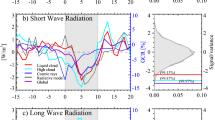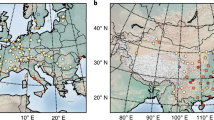Abstract
The thermal structure and composition of the atmosphere is determined fundamentally by the incoming solar irradiance. Radiation at ultraviolet wavelengths dissociates atmospheric molecules, initiating chains of chemical reactions—specifically those producing stratospheric ozone—and providing the major source of heating for the middle atmosphere, while radiation at visible and near-infrared wavelengths mainly reaches and warms the lower atmosphere and the Earth’s surface1. Thus the spectral composition of solar radiation is crucial in determining atmospheric structure, as well as surface temperature, and it follows that the response of the atmosphere to variations in solar irradiance depends on the spectrum2. Daily measurements of the solar spectrum between 0.2 µm and 2.4 µm, made by the Spectral Irradiance Monitor (SIM) instrument on the Solar Radiation and Climate Experiment (SORCE) satellite3 since April 2004, have revealed4 that over this declining phase of the solar cycle there was a four to six times larger decline in ultraviolet than would have been predicted on the basis of our previous understanding. This reduction was partially compensated in the total solar output by an increase in radiation at visible wavelengths. Here we show that these spectral changes appear to have led to a significant decline from 2004 to 2007 in stratospheric ozone below an altitude of 45 km, with an increase above this altitude. Our results, simulated with a radiative-photochemical model, are consistent with contemporaneous measurements of ozone from the Aura-MLS satellite, although the short time period makes precise attribution to solar effects difficult. We also show, using the SIM data, that solar radiative forcing of surface climate is out of phase with solar activity. Currently there is insufficient observational evidence to validate the spectral variations observed by SIM, or to fully characterize other solar cycles, but our findings raise the possibility that the effects of solar variability on temperature throughout the atmosphere may be contrary to current expectations.
This is a preview of subscription content, access via your institution
Access options
Subscribe to this journal
Receive 51 print issues and online access
$199.00 per year
only $3.90 per issue
Buy this article
- Purchase on Springer Link
- Instant access to full article PDF
Prices may be subject to local taxes which are calculated during checkout



Similar content being viewed by others
References
Brasseur, G. & Solomon, S. Aeronomy of the Middle Atmosphere: Chemistry and Physics of the Stratosphere (Springer, 2005)
Haigh, J. D. The role of stratospheric ozone in modulating the solar radiative forcing of climate. Nature 370, 544–546 (1994)
Harder, J., Lawrence, G., Fontenla, J., Rottman, G. & Woods, T. The Spectral Irradiance Monitor: scientific requirements, instrument design, and operation modes. Sol. Phys. 230, 141–167 (2005)
Harder, J. W., Fontenla, J. M., Pilewskie, P., Richard, E. C. & Woods, T. N. Trends in solar spectral irradiance variability in the visible and infrared. Geophys. Res. Lett. 36, L07801 (2009)
Lean, J. Evolution of the sun’s spectral irradiance since the Maunder Minimum. Geophys. Res. Lett. 27, 2425–2428 (2000)
Krivova, N. A., Solanki, S. K. & Floyd, L. Reconstruction of solar UV irradiance in cycle 23. Astron. Astrophys. 452, 631–639 (2006)
Krivova, N. A., Solanki, S. K., Fligge, A. & Unruh, Y. C. Reconstruction of solar irradiance variations in cycle 23: is solar surface magnetism the cause? Astron. Astrophys. 399, L1–L4 (2003)
Harder, J. W. et al. The SORCE SIM Solar Spectrum. Comparison with recent observations. Sol. Phys. 263, 3–24 (2010)
Harwood, R. S. & Pyle, J. A. A 2-dimensional mean circulation model for the atmosphere below 80km. Q. J. R. Meteorol. Soc. 101, 723–747 (1975)
Bekki, S. et al. The role of microphysical and chemical processes in prolonging the climate forcing of the Toba eruption. Geophys. Res. Lett. 23, 2669–2672 (1996)
Warwick, N. J., Bekki, S., Nisbet, E. G. & Pyle, J. A. Impact of a hydrogen economy on the stratosphere and troposphere studied in a 2-D model. Geophys. Res. Lett. 31, L05107 (2004)
Cahalan, R. F., Wen, G. Y., Harder, J. W. & Pilewskie, P. Temperature responses to spectral solar variability on decadal time scales. Geophys. Res. Lett. 37, L07705 (2010)
Randel, W. J. & Wu, F. A stratospheric ozone profile data set for 1979–2005: variability, trends, and comparisons with column ozone data. J. Geophys. Res. Atmos. 112, D06313 (2007)
Haigh, J. D. & Pyle, J. A. A two-dimensional calculation including atmospheric carbon dioxide and stratospheric ozone. Nature 279, 222–224 (1979)
Soukharev, B. E. & Hood, L. L. Solar cycle variation of stratospheric ozone: Multiple regression analysis of long-term satellite data sets and comparisons with models. J. Geophys. Res. 111, D20314 (2006)
Solomon, S. et al. (eds) Contribution of Working Group I to the Fourth Assessment Report of the Intergovernmental Panel on Climate Change (Cambridge University Press, 2007)
Larkin, A., Haigh, J. D. & Djavidnia, S. The effect of solar UV irradiance variations on the Earth’s atmosphere. Space Sci. Rev. 94, 199–214 (2000)
Fröhlich, C. Evidence of a long-term trend in total solar irradiance. Astron. Astrophys. 501, L27–L30 (2009)
Gray, L. J. et al. Solar influences on climate. Rev. Geophys. (in the press)
Acknowledgements
This work was partially funded by the UK Natural Environment Research Council SOLCLI consortium project. We are grateful to J. L. Lean for providing solar spectra, to W. J. Randel for advice on data analysis and to L. Froidevaux for advice on the EOS Aura-MLS data. The MLS data were obtained from the instrument website (http://mls.jpl.nasa.gov/index-eos-mls.php).
Author information
Authors and Affiliations
Contributions
J.W.H. provided the SIM and SOLSTICE data, information on its interpretation and on solar variability, R.T. provided input on stratospheric photochemistry, A.R.W. edited the SIM data into a format suitable for the model and carried out preliminary model runs, J.D.H. performed the model experiments and diagnostics, carried out the MLS data analysis and wrote the paper.
Corresponding author
Ethics declarations
Competing interests
The authors declare no competing financial interests.
Supplementary information
Supplementary Information
The file contains Supplementary Text on the 2D Model, MLS ozone data analysis and Ozone production and destruction rates. The file also contains additional references, Supplementary Table 1 and Supplementary Figures 1-4 with legends. (PDF 343 kb)
Rights and permissions
About this article
Cite this article
Haigh, J., Winning, A., Toumi, R. et al. An influence of solar spectral variations on radiative forcing of climate. Nature 467, 696–699 (2010). https://doi.org/10.1038/nature09426
Received:
Accepted:
Published:
Issue Date:
DOI: https://doi.org/10.1038/nature09426
This article is cited by
-
Stratospheric ozone, UV radiation, and climate interactions
Photochemical & Photobiological Sciences (2023)
-
A history of solar activity over millennia
Living Reviews in Solar Physics (2023)
-
Characteristics of solar-irradiance spectra from measurements, modeling, and theoretical approach
Light: Science & Applications (2022)
-
2470 million-year-old banded iron formation reveals a climatic oscillation consistent with the Gleissberg solar cycle
Communications Earth & Environment (2022)
-
SOLar-STellar Irradiance Comparison Experiment II (SOLSTICE II): End-of-Mission Validation of the SOLSTICE Technique
Solar Physics (2022)
Comments
By submitting a comment you agree to abide by our Terms and Community Guidelines. If you find something abusive or that does not comply with our terms or guidelines please flag it as inappropriate.



